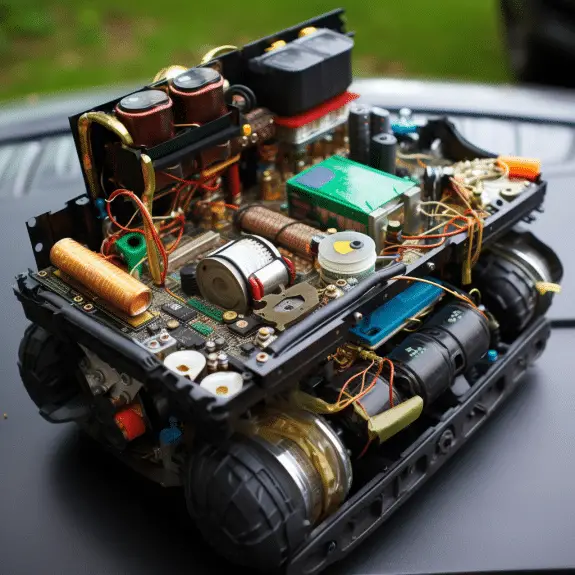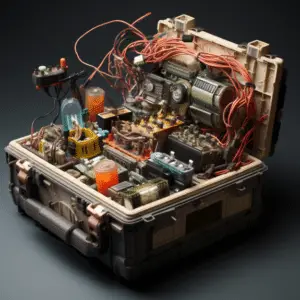
DIY Car Battery Installation Guide: Step-by-Step Tips

DIY car battery installation are a must-have for our vehicles. DIY installing can save time and cash, plus give you a better understanding of your car’s mechanics. Here’s a step-by-step guide:
- Safety first! Turn the ignition off. Park your vehicle in a ventilated spot. Wear protective gear like gloves and goggles. Have a fire extinguisher in case of accidents.
- Locate the car battery. Normally, it’s under the hood. Look at your vehicle manual if you’re not sure. Notice the positive (+) and negative (-) terminals. Don’t mix them up when connecting or disconnecting cables.
- Using a wrench or socket set, loosen and remove the negative cable (the black cable) first. Followed by the positive cable (the red cable). Don’t let any tools touch both terminals at the same time to avoid short-circuiting.
- Remove the old DIY car battery installation from its tray/bracket. It may be heavy, be careful. Put it in a safe spot.
- Time for the DIY car battery installation. Make sure it matches the specs of the old one (size and voltage). Place it firmly in the tray/bracket.
- Reversing the steps taken earlier, connect the positive cable (red) to the positive terminal. Then the negative cable (black) to its negative terminal. Tighten both with a wrench or socket set.
- Check the connections to make sure they’re securely attached. Close the hood and start the engine. If it starts, you’ve successfully installed your car battery!
Safety Precautions
- Always wear safety goggles and gloves when handling the DIY car battery installation. This is to guard against acid leaks or electrical shocks.
- Prior to starting any work, turn off the engine and remove the key from the ignition. This is to avoid accidental starts or electrical surges.
- Inspect the battery for signs of damage e.g. leaks or dents. If something is out of the ordinary, do not continue and get professional help.
- Keep all flammable materials away from the battery area. This includes cigarettes, open flames, and sparks from tools.
- When removing the old battery, disconnect the negative terminal first (marked with a minus sign). Then disconnect the positive terminal (marked with a plus sign). Doing this will make it safer to disconnect the electrical currents.
- Dispose of the old battery carefully by taking it to a recycling center or an authorised dealer. Do not throw it in regular rubbish bins as it can damage the environment.
- Besides, familiarize yourself with your car’s requirements before beginning the installation process. Each car is different, so refer to the owner’s manual for instructions.
Tools and Materials Needed
Tools and materials you need to install a DIY car battery installation depend on the make and model of your vehicle. However, some items are essential for a successful installation. Here’s what you need:
- Tool/Material: Socket Wrench. Description: Use it to remove and tighten battery terminal connections.
- Tool/Material: New Battery. Description: Get a compatible replacement battery that meets your vehicle’s specs.
- Tool/Material: Battery Cleaner. Description: Clean corrosion or dirt on the battery terminals.
- Tool/Material: Battery Terminal Brush. Description: Scrub away corrosion from battery terminals.
- Tool/Material: Protective Gloves. Description: Wear them to protect your hands from acid or chemicals.
Also, it’s recommended to have safety goggles and a wire brush. Safety goggles guard your eyes from debris or corrosive substances. A wire brush removes rust or dirt from the battery tray.
When using these tools, take precautions:
- Wear protective gloves to prevent injury or chemical exposure.
- Disconnect the negative terminal first before disconnecting the positive terminal. It will help avoid accidental electrical discharge or short circuit.
By having the needed tools and materials and following these tips, you can install a car battery yourself confidently. Remember to follow the instructions provided by your vehicle manufacturer for a safe installation.
Step 1: Prepare for Installation
To install a DIY car battery installation, you must first prepare. Here’s how:
- Get the tools you need: Wrench, pliers, cleaner and safety goggles.
- Protect yourself: Put on gloves and goggles.
- Know the battery’s position: Open the hood and get familiar with it.
- Disconnect negative terminal: Use a wrench to loosen the nut and remove the cable.
- Disconnect positive terminal: Do the same as above. Don’t touch metal surfaces with live wires!
Pro Tip: Disconnect and remove all electronic devices or accessories from the electrical system for safety.
By following these steps, you’ll be ready to install a new DIY car battery installation.
Step 2: Remove the Old Battery
To install a new DIY car battery installation, you must first remove the old one. Here are three simple steps to help you do it:
- Locate the battery. It is usually under the hood, but sometimes in the trunk or under the back seat. The car manual can help if you’re unsure.
- Detach the negative terminal. It’s usually marked with a minus (-) and colored black. Use a wrench or pliers to remove the nut that holds the cable. Then, put the cable away from metal surfaces.
- Detach the positive terminal. It’s usually marked with a plus (+) and colored red. Use a wrench or pliers to remove the nut that holds the cable. Then, keep the cable away from metal surfaces.
After doing these steps, you have removed the battery. However, different car models may require different steps. If you are not sure or face any issue, ask a professional to prevent any damage to your car.
Fun fact: According to AAA Automotive Research Center, almost one-third of roadside problems are due to dead or bad batteries.
Step 3: Clean the Battery and Terminal Connections
To keep your car running optimally, it’s key to clean the battery and terminal connections. This will prevent corrosion and allow for good electric flow. Here’s a guide on how to do it!
- Get tools – Collect a wire brush, baking soda paste, water, and safety goggles.
- Disconnect battery – Make sure the engine is off, and take out the keys from the ignition. Disconnect the negative terminal first, then the positive one.
- Check for corrosion – Look at both terminals for signs of corrosion or rust. Corrosion can stop electric conductivity and cause battery issues.
- Clean with baking soda – Mix baking soda and water to make a paste. Put it on the corroded areas of both terminals and scrub with a wire brush. Baking soda helps neutralize acidic corrosion.
- Rinse and dry – Scrub away the corrosion, then rinse off any leftovers. Make sure both terminals are completely dry before reconnecting (positive first).
Additional tips:
- Wear safety goggles when working around batteries.
- Don’t use too much force while scrubbing.
- Check for corrosion often.
- Baking soda and wire brushing help get rid of corrosion.
By following these steps, you can maintain a clean and efficient battery system. Keep your car running smoothly by cleaning your battery and terminal connections.
Step 4: Install the New Battery
It’s important to take the correct steps when installing a new car battery. This ensures a successful process and no harm to your vehicle or yourself.
- Locate the battery in the engine bay. It’s usually easy to spot – a big rectangular box with cables attached.
- Use a wrench or pliers to loosen and remove the negative cable (black) – do this gently. Do the same for the positive cable (red), remembering which one goes where.
- Take off any clamps or brackets that are keeping the battery in place. Lift it out of the tray.
- Read the manufacturer’s instructions before you install the new battery. This may include cleaning the terminals or spraying anti-corrosion. Doing this will help make your battery last longer and work better.
Installing your car’s new battery yourself will save you money on installation fees and give you valuable knowledge about car maintenance. Take charge of your automotive journey now!
Step 5: Secure the Battery in Place
Step 5: Secure the battery! Here’s a guide:
- Locate the battery hold-down bracket/clamp.
- Align it with the mounting holes.
- Put bolts/screws through the bracket/clamp, into the holes.
- Tighten them securely, but not too much!
It’s important to get a proper fit. Avoid movement or damage. Check your car’s manual for instructions. Safety is key – incorrect methods can cause damage/injury. Follow manufacturer guidelines for a successful installation.
Fun fact: Brackets/clamps to secure batteries have been used for many years. This ensures stability and reduces vibration that could harm the electrical system.
Step 6: Reconnect the Cables
Reconnecting your car battery cables? Don’t worry, here’s a guide to help!
- Locate the positive and negative terminals. One is marked with a plus sign (+), the other with a minus sign (-).
- First, attach the red/positive cable to the positive terminal. Make sure it’s securely connected and tightened.
- Next, attach the black/negative cable to the negative terminal. Securely connect and tighten.
- Check the connections. Are they loose or slipping off?
- When attaching cables, always connect positive first. Disconnect it last. This prevents accidental sparks or discharge.
- Also, follow any instructions from your car’s manufacturer. This’ll ensure reconnection is done correctly and safely.
Caution! My neighbor accidentally reversed the polarity when reconnecting the cables. This caused a minor electrical surge, damaging some of his car’s components. So be careful!
Reconnecting your car battery cables may seem easy, but it’s important to do it right. Follow these steps and stay cautious for optimal performance and safety.
Step 7: Check the Battery’s Functionality
It’s essential to check your newly installed car battery properly. Here are three steps to follow:
- Turn on the ignition and start the engine. Listen for any strange sounds or vibrations.
- Activate electrical features like headlights, wipers, and AC. See if they work without flickering.
- Measure the voltage output with a voltmeter. It should read 12.6 volts when not in use and 13.7 to 14.7 volts when running.
Remember, heat or cold can damage the battery. Test it in different weathers to check its performance.
Consumer Reports says car batteries lose 4% of capacity each year due to self-discharge (Source: consumerreports.org).
Troubleshooting Common Issues
Car batteries can give us headaches. Let’s look at some common problems and how to fix them.
- Check if the terminals are corroded. Clean them with a mixture of baking soda and water. This solution can get the car running again.
- It might not be the battery. Test it by starting the car and removing the negative terminal. If the car stops, the alternator may need to be inspected or replaced.
- Pay attention to noises or smells. This may mean internal damage or leaks. Don’t ignore these signs – they could lead to a breakdown or fire.
Regular maintenance is key for prevention. Look out for any signs of wear and tear on the battery.
Don’t let FOMO haunt you. Take care of the battery now, or risk being stranded on the side of the road.

Conclusion
Installing a car battery can be a tricky task. But, with the right knowledge and tools, it can be done without a trip to the mechanic. For safety, don’t forget to wear gloves and eyewear.
Here are the steps to install a car battery:
- Locate the battery under the hood and remove any connectors or fasteners.
- Then, disconnect the negative terminal first, followed by the positive terminal. Do not touch both terminals simultaneously!
- Clean the battery tray before placing the new battery.
- Connect the positive terminal first, followed by the negative terminal, and make sure they are tightly secured.
- Double-check all connections then start your car to make sure everything is working properly.
In the past, batteries were larger and needed maintenance. Mechanics had to refill them with distilled water. Now, they are smaller and maintenance-free due to technology advances.
Frequently Asked Questions
1. How do I safely remove the old car battery?
To safely remove the old car battery, first ensure the engine and all electrical systems are turned off. Then, locate the battery and carefully remove the negative cable (usually black) from the battery terminal, followed by the positive cable (usually red). Use a wrench or socket to loosen and remove the battery hold-down clamp. Finally, lift the battery out of its tray, taking care to avoid any spills or contact with metal objects.
2. What precautions should I take while installing a new car battery?
When installing a new car battery, it is important to follow certain precautions. Always wear protective gloves and goggles to prevent any injury or contact with battery acid. Ensure the new battery is the correct type and size for your vehicle. Clean the battery tray and terminals thoroughly before installing the new battery. Also, make sure to connect the positive cable first and the negative cable last to minimize any risk of electrical shocks.
3. How do I connect the new car battery?
Start by placing the new battery into the empty tray, ensuring it sits firmly and securely. Connect the positive cable (usually red) to the positive terminal of the battery and tighten it with a wrench or socket. Then, connect the negative cable (usually black) to the negative terminal and tighten it as well. Make sure both connections are snug but not overly tightened. Double-check that the cables are securely attached and won’t come loose during operation.
4. Is it necessary to register the new car battery?
Registering a new car battery is not always necessary but can be recommended for certain vehicles. Some modern cars with advanced electrical systems may require the battery to be registered or programmed to ensure optimal performance and to prevent any potential issues. It is best to consult your vehicle’s owner manual or the battery manufacturer’s instructions to determine if registration is required.
5. How often should I replace my car battery?
The lifespan of a car battery can vary depending on several factors such as climate, driving habits, and battery quality. On average, car batteries last around 3 to 5 years. However, it is important to monitor your battery’s performance regularly. If you notice signs of a weak battery such as difficulty starting the engine, dim headlights, or frequent jump-starts, it may be time to replace your battery.
6. How should I dispose of an old car battery?
Old car batteries should never be disposed of in regular trash or recycling bins. They contain hazardous substances and materials that can harm the environment if not properly handled. Instead, take your old battery to a local auto shop, battery retailer, or a designated recycling center. Many of these places offer recycling programs for used car batteries to ensure proper disposal and prevent any negative impact on the environment.
